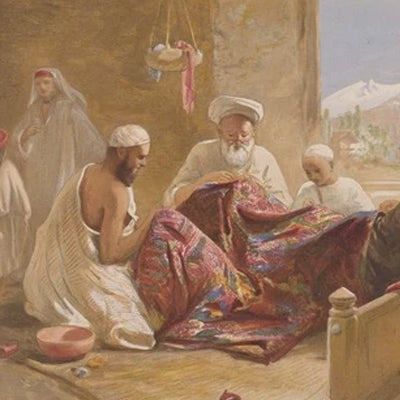Pashmina wool, an introspection in history

In the beginning, pashmina wool was simply the Persian "Pasha" meaning "wool". This was a “special wool” from Kashmir, from the hair of goats bred for their fine fiber. "Pashminas" became widely known as hand-woven shawls that were super fine, light in weight and diversely colored.

Muslim shawl makers, Kashmir
Cashmere shawls were appreciated for their softness and warmth. Their rich colours, the intricacy of weave and design made them very popular. Handmade from fine “pasha” wool, collected from the downy under fur of a Himalayan mountain goat (Capra hircus).

Capra hircus, Ladakh
From the 15th century, successive rulers of Kashmir, including the Mughals, continued the evolution of the cashmere shawl.
Then Europeans started to contribute heavily to its popularity in the 17th century. The French preferred general orientalist designs, sending patterns to agent's houses in Srinagar to be made up in Kashmir, while British went for local designs.

Shawl-weavers in Kashmir
Pashmina shawls soon moved in several design directions from superfine wraps to the more intricate woven (called tiliwalla, tilikar or kani kar) and embroidered designs, (amlikar) which tended to be heavier in nature.
From cashmere to pashmina
Originally being so remote, the goat hair was collected in spring as it was shed out in the wild, or combed by hand by the herders. Today, this process essentially remains the same, although rather than wait and collect the fibre off stray bushes, when the moulting season arrives, the goats are promptly combed to obtain the fibre.

Woven sheer cashmere wraps by Olivia Graham Cashmere
With the improved technology available in the textile industry, the fibre is now able to be processed quickly and efficiently. Cleaning, carding and combing (separating the coarser guard hair from the fine down, all very important if you want an exquisitely fine pashmina shawl).
Wraps are then woven to create a wrap so sheer you can literally read a book through it. And, of course, as tradition dictates, a true pashmina should be fine enough to slip through your wedding ring!
Image sources:
- By William Simpson [Public domain], via Wikimedia Commons
- By Redtigerxyz (Own work) [CC BY-SA 3.0 (http://creativecommons.org/licenses/by-sa/3.0) or GFDL (http://www.gnu.org/copyleft/fdl.html)], via Wikimedia Commons
- By Underwood & Underwood. [Public domain or Public domain], via Wikimedia Commons
- Olivia Graham Cashmere
1 Response
Leave a comment
Comments will be approved before showing up.
Also in Journel

History of Cashmere Research - Yezdajird
As with any research, it is very easy to get lost in a journal paper, with mysterious hints of cashmere textiles, tonight I have been reading about the last of the Sassanian Rulers...

A little history of Scent - early perfumes...
Am doing an online masterclass this morning on scared scents with Sal from Perfect Potion, which is very interesting and it got me thinking about the beginnings of perfume creation...

Amazing Wool...
Wool in History... Important to communities since prehistoric times, providing food, and later with selective breeding warmth & comfort with the use of the fibre for clothing, blankets, carpets, even living accommodation (yurts) in it's felted form.

Jazzmin
June 09, 2016
I loved this !! cashmere pashmina